WHY SHOULD I VISIT MADAGASCAR?
Here are the top five reasons why you should visit Madagascar:
- Unique wildlife – lemurs are the most well-known
- Unique flora – over 80% of 15000 species are endemic
- Outstanding beaches and idyllic islands
- Avenue of Baobabs
- The stone forest of Tsingy Bemaraha
There is no other place on earth that can boast that over 90% of its wildlife species and 80% of its plant species are endemic. Madagascar is home to 860 species of orchid, with 650 being endemic. Visiting Madagascar is truly a unique experience.
When Is the Best Time of The Year to Visit Madagascar?

Aftermath of a cyclone
Madagascar is the fourth-largest island in the world, and the best time to visit Madagascar depends largely on what you want to experience.
Roughly speaking, the best time is April to December. I have given you a short breakdown, month by month, to help you choose when to visit.
- January – very wet.
- February – wet and with the possibility of cyclones.
- March – slightly less wet, but with the chance of cyclones.
- April – starting to get cooler and has less rain. Most National Parks start to open.
- May – one of the best months to visit, as rain has decreased. The days are sunny, it is cooler, and it is just before the peak period, so not as expensive.
- June – this is the start of the whale-watching season and the best month to visit the south-western part of the island.
- July – it is getting much cooler and dryer, so it is a great time to visit.
- August – some species of lemurs and chameleons go into hibernation. A coastal holiday is better than exploring the interior. It is cooler.
- September – it starts getting warmer, and some of the hibernating animals start getting active.
- October – this is the season for baby lemurs. Hibernation is finished, so it is a great time to see wildlife. It is sunny and dry.
- November – Most probably the best month for fauna and flora, sun, and little rain.
- December – this is the hottest month and the start of the wet season.
For birders, August to December would be the best time, depending on what species you are interested in.
How long should I visit Madagascar for?
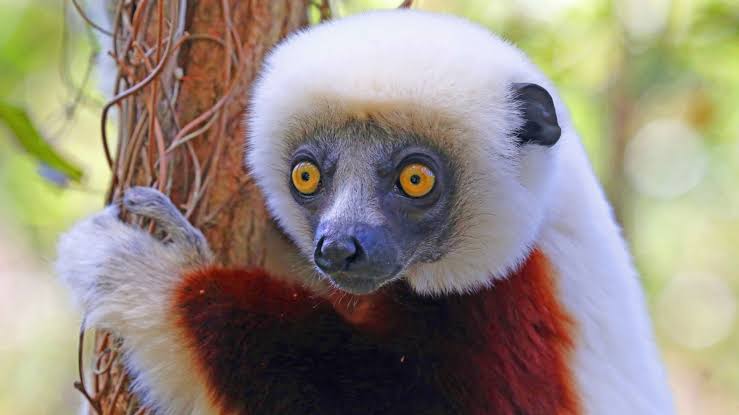
Lemur s are unique to Madagascar
As it is a long-haul destination from virtually anywhere, I would suggest that seven nights would be the minimum. As most of the National Parks can only be explored on foot, a relative level of fitness is required.
- For a short stay, four to seven nights, I would suggest a beach destination like Ile Saint Marie or Nosy Be.
- If you want to explore the fauna and flora of Madagascar, 10 days to 15 days is recommended, on top of which you can add a couple of days relaxing on the coast.
- To experience most of what Madagascar has to offer, 20 or more days will be needed, and then there is still a bit of hit and run.
What is the weather like in Madagascar?

Sunny beach weather
Madagascar ‘s weather is divided into two seasons: the rainy season, November to April, and the dry season from April to October. Essentially subtropical, especially at the coast where it is never completely dry, the rainfall and temperatures are lower than in the higher lying areas and mountains.
Madagascar is prone to cyclones during February and sometimes in March.
Most of the rain (and cyclones) come from the east trade winds, and so, the east coast of Madagascar gets huge amounts of rain and is hot and humid throughout the year. As you move westwards from the coast on to the central highlands and more mountainous regions, the rains decrease in volume and temperatures drop and become more temperate, particularly when you get to the mountains where it can get quite cold. Moving further west, it gets dryer still, and the north-west coast is warm to hot throughout the year. The south-west and south are basically semi-desert areas with the far south getting the least amount of rain.
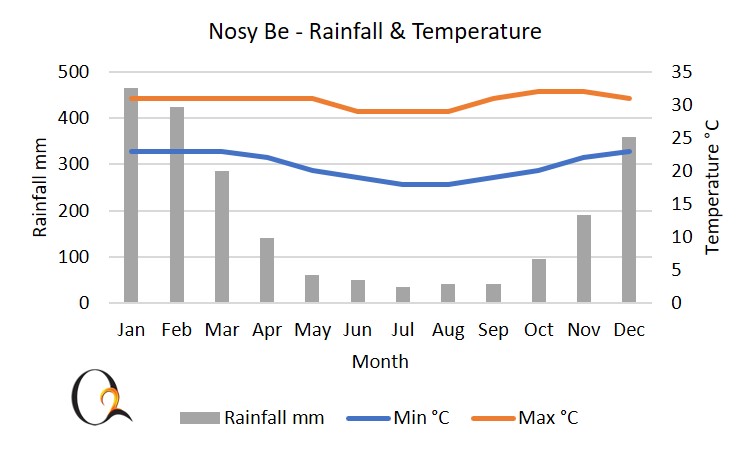
Nosy Be and northern Madagascar Climate Chart

Antananarivo & central highlands climate chart

West Coast Climate Chart
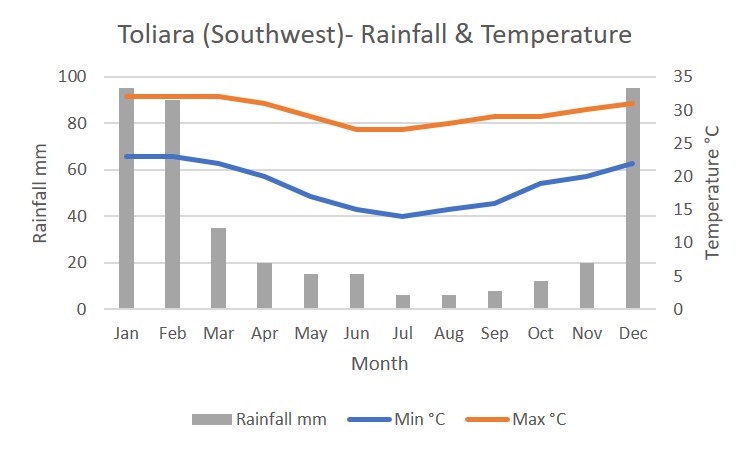
Southwestern Madagascar Climate Chart

East Coast Climate Chart
Do I need a visa to travel to Madagascar?
All visitors need a visa to travel to Madagascar. The visa can be obtained at a consulate, online, or on arrival.
What are the health requirements for Madagascar?
Madagascar is a malaria risk area. In the coastal areas, particularly the east coast and wet northern part of Madagascar, the risk is very high. The risk is lower on the central plateau and highlands. Anti-malaria medication is recommended, and you should consult your doctor in this regard. To minimise the risk of contracting malaria, wear long trousers and cover your arms in the evening, and apply mosquito repellent.
Yellow fever vaccination is required if you are coming from an endemic country. The following vaccinations are recommended, but not compulsory:
- Hepatitis A and B
- Typhoid
- Poliomyelitis
- Rabies
- Meningococcal meningitis
- Cholera
- Chickenpox
- Shingles
- Pneumonia
- Influenza
- Tetanus, diphtheria, and pertussis (Tdap)
- Measels, mumps, and rubella (MMR).
How do I get around in Madagascar?
The roads in Madagascar are very bad. We suggest that you join an organised tour or hire a private driver. There are flights between the main cities. The locals get around by taxi brousse (old 15-seater), which are very unreliable, and because of the state of the roads, take a long time to get anywhere.
TOP TOURIST ATTRACTIONS
Avenue of Baobabs

Avenue of Baobabs en route to Morondava
This avenue of these unique trees was not planted by human hands, as the name may seem to indicate. These amazing specimens grew naturally alongside the dirt road between Morondava and Belo Tsiribihina in central western Madagascar.
Nosy Be

Nosy Be
Nosy Be is the largest of 20 islands that are dotted around the north-west coast of Madagascar and Madagascar’s number one beach destination. In the south of the island is Lokobe Strict Reserve, home to the last remaining forest on Nosy Be. Here you can see the rare Black Lemur, chameleons, and one of the world’s smallest frogs either by walking, mountain, or quad biking. Activities on the island include snorkelling, excellent diving, quad biking, sailing, mountain biking, and swimming in the ocean.
Island hopping is an excellent way to get the most out of your stay on Nosy Be. Day trips are available to:
- Nosy Iranja; essentially two islands, Nosy Iranja Be and Kely, they are linked by a 2 km-long sandbar, which gets covered with water at high tide, making it two islands.
- Nosy Tanikely: While the beaches are not fantastic, it is an excellent island for diving and snorkelling.
- Nosy Komba: The main reason to visit this island is to see the lemurs, Aldabra Tortoises, and chameleons.
Tsingy de Bemaraha National Park and Integral Reserve
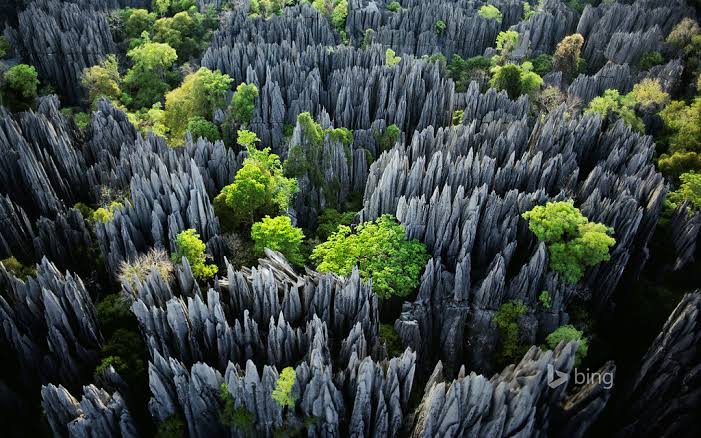
Rock formations to make the eyes water at Tsingy
Located in central north-west Madagascar and made up of the Great Tsingy and Little Tsingy, it was declared an UNESCO World Heritage site in 1990. Tourists are not allowed in the Integral Reserve in the north, but only into the National Park in the south. It is designated as a mineral forest, a forest of limestone pinnacles that resulted from the original plateau being eroded to form this impressive labyrinth of karstic formations.
Besides its unusual beauty, you will also be able to explore gorges, forests, waterfalls, and the fauna and flora of the area, of which 87% are endemic and a huge 47% of those only occur in this small area.
The fauna includes 11 lemur species, 100 species of birds, and 45 species of reptiles and amphibians.
Ile Sainte Marie

Ile Sainte Marie courtesy of Princesse Bora resort
The island of Ile Sainte Marie has several islets scattered around it. Aux Nattes is great for swimming and aux Sables for its beautiful forest and a sea cave. Nosy Boraha, its other name, is 57 km long and offers sandy beaches, numerous bays, and intimate coves, all protected by a coral reef. The island has a few small villages, a well-developed tourist infrastructure, and the Ikalalao forest, which boasts orchids and three species of lemur. The best ways to explore the island is by bicycle or on foot. The east coast of the island is more rugged than the west and less developed. The best areas of the island for swimming are the north and east.
The island is great for whale watching, turtle breeding, exploring the mangroves by pirogue, snorkelling, diving, cycling, walking, and enjoying the many sandy beaches and warm Indian Ocean.
Ranomafana National Park

Waterfall in Ranomafana
One of Madagascar’s most beautiful parks, it is essentially made up of mountains. The mountains are covered lush forests and have several streams that cascade down into the Namorona River, which bisects the park, and on which a hydroelectric power plant is built further downstream. The park is easily accessible from the main road, which has resulted in increasingly being part of tourists’ itineraries. With 12 species of lemur, including the rare Golden Bamboo Lemur, it boasts several carnivorous plants and orchid species as well.
The park can be explored on foot. There are five circuits developed to do this, ranging from a few hours to three days.
Masoala National Park

Humpback whale breaching in Antongil Bay
This is Madagascar’s largest protected area and is a combination of rainforest and marine reserve. It is situated in north-eastern Madagascar, and is made up of corals reefs, bays, swamps, mangrove forests, and coastal- and flooded rainforests. The humpback whales congregate in protected Antongil Bay during their breeding season. Over 3000 species of fish have been documented.
The park is explored on the many trails on offer, and activities can include biking, sea kayaking, snorkelling, guided forest walks, birding, whale watching, and fishing.
Compared to most of the national parks in Madagascar, this one is easily accessible by a variety of means, including motorboat.
Andasibe-Mantadia National Park

Largest lemur of them all, the Indri
Only three hours from Antananarivo on a good tar road, this national park is the most easily accessible in Madagascar. Home to Madagascar’s largest lemur, the Indri, it also boasts ten other lemur species. Mainly rainforest, the park can be explored by walking one of several circuits that range from one to six hours in length and suit most people’s fitness levels.
The park is also known for its orchids. Over 100 species form a spectacular sight when flowering between September and January. The park is also home to about 100 bird species and the island’s largest chameleon, the Bao Manditra.
Isalo National Park
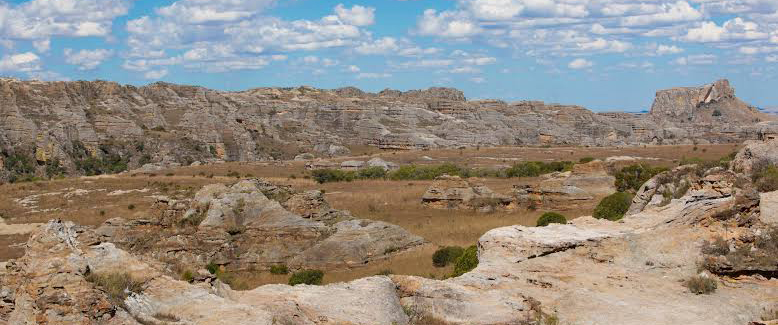
Beauty of Isalo National park
Situated in the dry south-west of Madagascar, the national park is characterised by grasslands, deciduous forest, canyons, rivers with pools to swim in, and formations of sandstone. 13 of the plant species here are found nowhere else. It is also the playground of several species of lemur, 100 species of bird (of interest would be the Benson’s rock thrush), and many reptile and amphibian species.
Ifaty

Ifaty at Sunset
Ifaty is made up of the villages of Mangily and Madio Rano. These sleepy fishing villages are the ideal settings to enjoy a few days on the beach after a trip through Madagascar. Snorkelling, diving, whale watching, and sunbathing are all activity options.
Contact Q2 Travel to help you get the most out of your visit to the most unusual country in the world.
GENERAL INFO&HISTORY
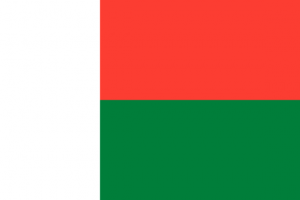
Madagascar Flag
Madagascar is the fourth-largest island in the world at 581 540 km², and is about 400 km off the shores of the African continent. The people of Madagascar speak Malagasy and French, and both are official languages. The capital city is Antananarivo, which is also its largest city. The main airports are Ivato (Antananarivo) International Airport and Fascene Airport (Nosy Be). There are several small domestic airports.
Brief History
It is not quite certain when the first people arrived in Madagascar. It, however, seems that the first settlements sprung up in the south-eastern part of Madagascar. There is some evidence that Bantu people from East Africa may have arrived in Madagascar in the sixth and seventh centuries. People from the settlements in the south-eastern part of Madagascar had moved inland to the central highlands (Imerina) by 600 AD, and they became known as the Vazimba. Those that remained on the coast became known as Veso. The Vazimba started to clear the forest and to plant crops.
The Omani Arabs, according to the earliest recorded Madagascan history, established trading posts along the north-west coast in the seventh century. It was during this period that the Arab culture, writing, and religion were introduced into Madagascar. As an important part of the trade route between Africa and Asia, Madagascar served as both a trading post and port. It is believed that it was during this period that the Bantu and Swahili people came to Madagascar as traders or sailors.
There are indications that Austronesian people from the Sunda Islands (Malaysia) may have arrived on Madagascar’s west coast in about 700 AD or shortly thereafter. This reasoning is based on the assumption that it was possible that ships from Indonesia/Malaysia could have managed to reach Madagascar’s shores during the eighth century.
By the tenth and eleventh centuries, some Arab and Zanzibar slavers settled on the west coast.
On his way to India, in the 15th century, Diogo Dias’s ship was blown off course, and he became the first European to set foot on Madagascar. This was the start of the trade between Portugal and Madagascar. By the 15th century, Europeans had taken over the spice trade from the Arab Muslims. Over the next 200 years, it was the English and French that would try to establish a foothold in Madagascar, but these attempts failed due to hostile locals and disease.
During the Middle Ages, chiefdoms were established in various parts of Madagascar. Due to trade with the Arabs and then the Europeans, some of these chiefdoms grew strong. During conflicts between the chiefdoms, prisoners were often sold as slaves. With the arrival of the European slave traders, trade in slaves became more and more lucrative. Tribes would deliberately war with each other to enslave the losers and sell them to the slave traders, all the while using the weapons supplied to them by the Europeans.
Madagascar has a long history of pirates. Between the 16th and 18th centuries, piracy was rife, and Ile Sainte Marie and Antongil Bay on the north-east coast became the centre or pirate operations.
By the early 19th century, almost all of Madagascar’s kingdoms had been united by the Merina King Andrianampoinimerina (first king of Madagascar) and his son Radama. Merina kings would rule over Madagascar until 1895.
Due to Treaty of Belin, the British recognised the right of the French to exert influence over Madagascar in exchange for British control over Zanzibar. A treaty of alliance between France and Madagascar was signed in 1885. The disputes on how this treaty should be implemented caused France to invade Madagascar in 1895, colonize the country, and send its queen into exile.
Important milestones in Madagascar’s path to independence include the Overseas Reform Act of 1956, where some powers of the government in Paris were transferred to the colonial governments, Madagascar becoming an autonomous state within the French Community in 1958, and full independence on 26 June 1960. Madagascar’s first president was Philibert Tsiranana. French settlers started to leave Madagascar, resulting in a skills vacuum.
Due to protests over his policies, Tsiranana stepped down in 1972 in favour of General Ramanantsoa who started to align Madagascar with the Soviet Union. In 1975, Colonel Ratsimandrava became president, but was assassinated shortly after the elections. In June of that year, Lieutenant-Commander Ratsiraka mounted a successful coup and was subsequently elected for a 7-year term. He cut ties with France and nationalised the economy, leading to a sharp decline in Madagascar’s economy. It was in the 1980s that Madagascar again aligned itself with France and opted for a market economy.
In 1992, and new democratic constitution was adopted, and in 1993, the first multi-party democratic elections and Albert Zafy was the victor. Following his impeachment, Ratsiraka was again elected as president, but with disputed provincial elections in 2000 and presidential elections in 2001, supporters of the two candidates took to the streets in violent clashes.
After a recount, the court declared Marc Ravalomanana the winner. Ratsiraka was eventually exiled to France. Ravalomanana, the IMF, and World Bank worked hard to reform the economy and put an end to corruption. He was re-elected in 2007, but then proceeded to suspend the National Assembly in order to rerun the election to reflect the results of a constitutional referendum held earlier that year.
He also closed down a TV station owned by Andry Rajoelina over its interview with ex-president Ratsiraka. Protests lead by Rajoelina, Antananarivo’s mayor, demanding a new government turned violent. Rajoelina proclaimed himself to be in control of the country, but was soon relieved of his position as mayor of Antananarivo. Security forces opened fire on opposition supporters, killing 28 people. Soldiers refused to obey presidential orders and repress the civilian population. The army stepped in and gave the opponents 72 hours to come up with a solution or face military intervention. Ravalomanana suggested a referendum, but handed the army his resignation, fearing further unrest. The courts and army handed the country over to Rajoelina.
Economy
Madagascar’s economy has been growing over the last four years. However, still over 70% of the inhabitants live under the breadline. The services sector is the fastest-growing sector. Over 80% of Madagascar’s economy is based on the agricultural, fishing, and forestry sector. The main exports are rice, cassava, vanilla, coffee, pepper, cloves, and sugar. Textiles, mining, and an emerging tourism sector form the majority of the rest of the economy.
Money
The currency of Madagascar is the ariary, but the Euro, USD, and GBP are widely accepted, but change may be a problem in these currencies.
Contact Us & Sitemap
Latest Articles
- African Safari Tours – Part 4 – Big 3 African Transfrontier ParksDecember 9, 2019 - 7:57 am
 African Safari Tours – Part 3 – Zimbabwe’s trio of safari must dos.November 18, 2019 - 7:07 am
African Safari Tours – Part 3 – Zimbabwe’s trio of safari must dos.November 18, 2019 - 7:07 am African Safari Tours – Part 2 – Unique Animals of AfricaNovember 14, 2019 - 6:52 am
African Safari Tours – Part 2 – Unique Animals of AfricaNovember 14, 2019 - 6:52 am African Safari Tours – Part 1November 13, 2019 - 5:27 am
African Safari Tours – Part 1November 13, 2019 - 5:27 am African ToursSeptember 26, 2019 - 11:25 am
African ToursSeptember 26, 2019 - 11:25 am


